Related Research Articles

The Napier Lion is a 12-cylinder, petrol-fueled 'broad arrow' W12 configuration aircraft engine built by D. Napier & Son from 1917 until the 1930s. A number of advanced features made it the most powerful engine of its day and kept it in production long after other contemporary designs had been superseded. It is particularly well known for its use in a number of racing designs, for aircraft, boats and cars.
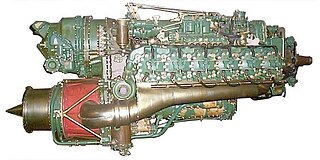
The Napier Nomad is a British diesel aircraft engine designed and built by Napier & Son in 1949. They combined a piston engine with a turbine to recover energy from the exhaust and thereby improve fuel economy. Two versions were tested, the complex Nomad I which used two propellers, each driven by the mechanically independent stages, and the Nomad II, using the turbo-compound principle, coupled the two parts to drive a single propeller. The Nomad II had the lowest specific fuel consumption figures seen up to that time. Despite this the Nomad project was cancelled in 1955 having spent £5.1 million on development, as most interest had passed to turboprop designs.
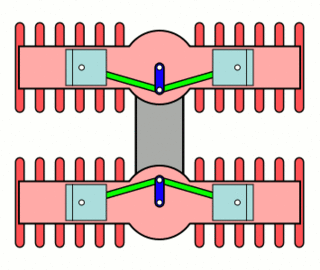
An H engine is a piston engine comprising two separate flat engines, most often geared to a common output shaft. The name "H engine" is due to the engine blocks resembling a letter "H" when viewed from the front. The most successful "H" engine in this form was the Napier Dagger and its derivatives. The name was also applied to engines of the same basic layout, but rotated through 90 degrees—most famously the Napier Sabre series. A variation on the "H" theme were the Fairey Prince (H-16) & Fairey P.24 Monarch, where the two engines retained separate drives, driving Contra-rotating propellers through separate concentric shafts. Although successful, they only existed in prototype form.
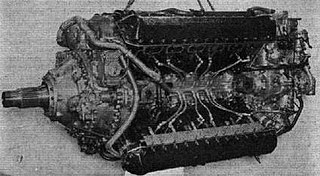
The Rolls-Royce Vulture was a British aero engine developed shortly before World War II that was designed and built by Rolls-Royce Limited. The Vulture used the unusual "X-24" configuration, whereby four cylinder blocks derived from the Rolls-Royce Peregrine were joined by a common crankshaft supported by a single crankcase. The engine was originally designed to produce around 1,750 horsepower (1,300 kW) but problems with the Vulture design meant that the engines were derated to around 1,450 to 1,550 hp in service by limiting the maximum rpm.

The BMW 803 was a German aircraft engine, an attempt by BMW to build a high-output aircraft engine by coupling two BMW 801 engines back-to-back, driving contra-rotating propellers. The result was a 28-cylinder, four-row radial engine, each comprising a multiple-bank in-line engine with two cylinders in each bank, which, due to cooling concerns, were liquid cooled.
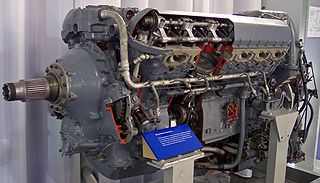
The Rolls-Royce Griffon is a British 37-litre capacity, 60-degree V-12, liquid-cooled aero engine designed and built by Rolls-Royce Limited. In keeping with company convention, the Griffon was named after a bird of prey, in this case the griffon vulture.

The Kestrel or type F is a 21 litre 700 horsepower (520 kW) class V-12 aircraft engine from Rolls-Royce, their first cast-block engine and the pattern for most of their future piston-engine designs. Used during the interwar period, it provided excellent service on a number of British fighters and bombers of the era, such as the Hawker Fury and Hawker Hart family, and the Handley Page Heyford. The engine also sold to international air forces, and it was even used to power prototypes of German military aircraft types that were later used during the Battle of Britain. Several Kestrel engines remain airworthy today.

The Rolls-Royce Eagle Mk XXII is a British 24-cylinder, sleeve valve, H-block aero engine of 46 litre displacement. It was designed and built in the early-1940s by Rolls-Royce Limited and first ran in 1944. It was liquid-cooled, of flat H configuration with two crankshafts and was capable of 3,200 horsepower at 18 psi boost.
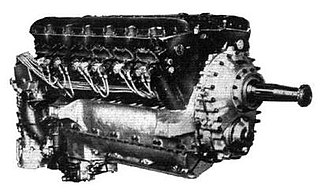
The Rolls-Royce Goshawk was a development of the Rolls-Royce Kestrel that used evaporative or steam cooling. In line with Rolls-Royce convention of naming piston engines after birds of prey, it was named after the goshawk.

The Armstrong Siddeley Jaguar was an aircraft engine developed by Armstrong Siddeley. The Jaguar was a petrol-fuelled air-cooled 14-cylinder two-row radial engine design. The Jaguar III was first used in 1923, followed in 1925 by the Jaguar IV and in 1927 by the Jaguar VI. In 1925 the Jaguar became the first production aero engine incorporating a geared supercharger.
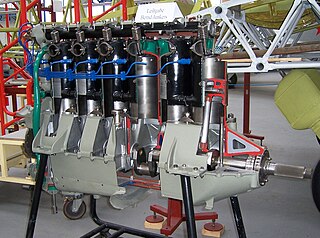
The Junkers L 5 was a six-cylinder, water-cooled, inline engine for aircraft built in Germany during the 1920s. First run in 1925, it was a much enlarged development of the Junkers L2.

The Rolls-Royce Exe, or Boreas, was a 24-cylinder air-cooled X block sleeve valve aircraft engine intended primarily for the new Fairey Fleet Air Arm aircraft, particularly the Fairey Barracuda. The Exe was relatively powerful for its era, producing about 1,100 hp (820 kW). This is notable given the relatively small 1,300 cubic inches (22 L) displacement, the Merlin requiring 1,600 cubic inches (27 L) for approximately the same power level. The X-24 layout made this quite a compact engine.

The Blackburn Cirrus Major is a British, inline-four aircraft engine that was developed in the late 1930s.

The Armstrong Siddeley Tiger was a British 14-cylinder air-cooled aircraft radial engine developed by Armstrong Siddeley in the 1930s from their Jaguar engine. The engine was built in a number of different versions but performance and dimensions stayed relatively unchanged. The Tiger VIII was the first British aircraft engine to use a two-speed supercharger.

The Napier Dagger was a 24-cylinder H-pattern (or H-Block) air-cooled engine designed by Frank Halford and built by Napier before World War II. It was a development of the earlier Napier Rapier.

The Napier Rapier was a British 16-cylinder H pattern air-cooled aero engine designed by Frank Halford and built by Napier & Son shortly before World War II.

The Napier Culverin was a licensed built version of the Junkers Jumo 204 six-cylinder vertically opposed liquid-cooled diesel aircraft engine built by D. Napier & Son. The name is derived from the French word, culverin, for an early cannon or musket. First flown in 1938, the engine went into limited production, with testing carried out on a Blackburn Iris V biplane flying-boat aircraft and Fairey IIIF biplane.
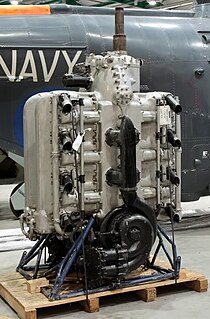
The Fairey P.24 Monarch was a British experimental 2,000 hp class H-24 aircraft engine designed and built by Fairey in the late 1930s. The engine did not go into production.

The Fiat AS.6 was an unusual Italian 24-cylinder, liquid-cooled V configured aircraft racing engine designed and built in the late-1920s by Fiat especially for the Schneider Trophy air races, but development and running problems meant that it was never able to compete. Although the engine suffered from technical problems, it was later used to set a speed record for piston-powered seaplanes that still stands today.
The Fiat AS.5 was an Italian 12-cylinder, liquid-cooled V engine designed and built in the late-1920s by Fiat especially for the 1929 Schneider Trophy air race.
References
Notes
- ↑ Gunston 1989, p.56.
- ↑ Lumsden 2003, p.149.
- ↑ "Archived copy". Archived from the original on 22 December 2015. Retrieved 3 November 2011.
{{cite web}}: CS1 maint: archived copy as title (link) - ↑ Lumsden 2003, p.150.
Bibliography
- Gunston, Bill. World Encyclopedia of Aero Engines. Cambridge, England. Patrick Stephens Limited, 1989. ISBN 1-85260-163-9
- Lumsden, Alec. British Piston Engines and their Aircraft. Marlborough, Wiltshire: Airlife Publishing, 2003. ISBN 1-85310-294-6.